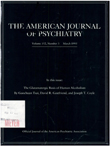Young female alcoholics with and without eating disorders: a comparative study in Japan
Abstract
OBJECTIVE: The authors sought to delineate the characteristics of female alcoholics with eating disorders. METHOD: The study subjects were 29 female Japanese outpatients and inpatients, 30 years of age or younger, with DSM-III-R diagnoses of either alcohol dependence or alcohol abuse and eating disorders. Twenty-one female alcoholics within the same age range who did not have eating disorders served as the comparison group. The social and familial backgrounds, clinical course, and clinical symptoms of the two groups were compared with the use of a structured interview form developed for the study. RESULTS: Ninety- three percent of the subjects with eating disorders had bulimia nervosa; 52% had anorexia nervosa. In all cases, both disorders continued after the onset of problem drinking. The age distributions of the two groups of alcoholic subjects clearly differed: no one in the comparison group was under the age of 24, and the number of comparison subjects increased with age after age 24, whereas the subjects with eating disorders ranged in age from 19 to 30 years, with the greatest number at age 26. More of the alcoholic subjects with eating disorders had never been married, they had had an earlier onset of alcoholism, and they had lower body weights than those without eating disorders. Also, more of them had depression and borderline personality disorder. CONCLUSIONS: The findings suggest that young female alcoholics with eating disorders constitute a clinical subgroup of alcoholics with distinct sociodemographic characteristics and a clinical course and symptoms that differ from those of both younger and older female alcoholics without eating disorders.
Access content
To read the fulltext, please use one of the options below to sign in or purchase access.- Personal login
- Institutional Login
- Sign in via OpenAthens
- Register for access
-
Please login/register if you wish to pair your device and check access availability.
Not a subscriber?
PsychiatryOnline subscription options offer access to the DSM-5 library, books, journals, CME, and patient resources. This all-in-one virtual library provides psychiatrists and mental health professionals with key resources for diagnosis, treatment, research, and professional development.
Need more help? PsychiatryOnline Customer Service may be reached by emailing [email protected] or by calling 800-368-5777 (in the U.S.) or 703-907-7322 (outside the U.S.).



